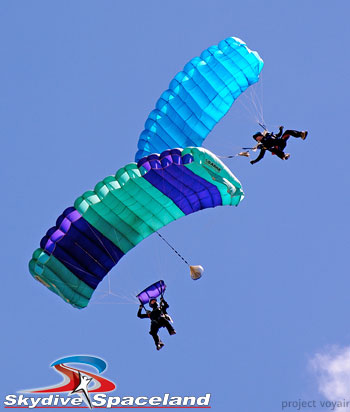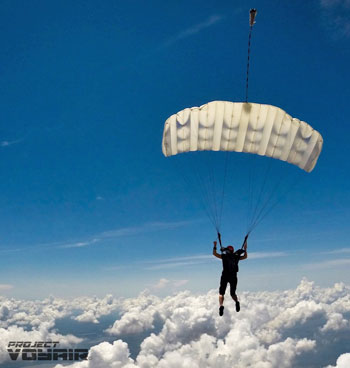So you are ready to get that shiny new wing, or sell your current canopy. Well caveat emptor[1], good readers. Are you making good decisions about this purchase, or the sale of your “old” wing? We are seeing a disturbing, fatal trend among skydivers worldwide as newer, faster wings come onto the market and older wings become perceived as less high-performance. To help combat this, we all need to examine our mindsets when it comes to buying and selling canopies.

Canopy changes affect other skydivers as well as ourselves; we must do our due diligence on preparing that person to fly that wing safely, whether it’s ourselves or the people buying our old wings. We may not be in a position to train a buyer to fly the wing safely, but we absolutely are in a position to assess that person’s skill and determine whether he or she is a good fit for that wing or if it will be a loaded gun in untrained hands.
This article is not designed as a guide for canopy progression (which should be done with the help of a suitably qualified canopy coach, instructor, or subject matter expert), but rather to get you to think about the evolution of wings and how we can all continue to push the limits of our sport without needlessly increasing our risk. You don’t have to be an expert canopy pilot or a sponsored athlete to enjoy flying a high-performance wing, as today’s wings offer many advantages over their ancestors in performance, design, and construction. And this, sports fans, is the very heart of the problem.
What’s Trending?
People always want more. Release a new sports car, digital altimeter, or mobile phone and pretty soon a lot of people want it. Parachutes are no different; every time a new canopy design is released, a glut of “last-generation” high-performance canopies hits the market as people buy up the new canopies and sell off their old wings.
This has happened with every new advancement in the canopy market, whether it was the release of the Performance Designs (PD) Stiletto in 1992 or the recent release by NZ Aerosports (NZ Aero) of the Leia. Once the new canopy arrives, the sales begin as skydivers sell the old to purchase the new, or purchase the latest and greatest to keep up. A quick search of Dropzone.com today found about 220 used Crossfire, Katana, Stiletto, Velocity, JFX, and JVX canopies for sale (2/10/16); all of these could be considered “previous generation” high-performance wings.
There is nothing wrong with wishing to upgrade your wing or sell the old. This is the evolution of our sport, but the key to buying or selling a canopy is to keep that skydiver on the new wing—yourself as the buyer, or your buyer if you’re selling—within their capabilities. Putting a skydiver under a higher-performance wing without the pre-requisite experience to fly it safely is creating a whole new type of problem. This problem is being observed at dropzones around the world, and is well summarized by comments from Bryan Burke of Skydive Arizona, who is one of the world’s foremost experts on skydiving safety.
“I’m very concerned that a lot of people will be buying used canopies as the more ‘expert’ jumpers sell off their Velocities, Xaos’, and JVXs to get Leias and Valkryies,” says Burke. “The latest fatalities [at Skydive Arizona, early 2016] were visitors from out of state, uncurrent, and especially in the latter case, not trained. One individual had downsized to the Velo from a Spectre 120! I never would have let him jump it if I had known. Now it seems like we might need to start screening visitors for appropriate choice of main and adequate training and supervision.”
Skydivers don’t want dropzones to screen their canopy choices, and trust me, drop zones don’t want the hassle of doing it either! But some drop zones may choose to screen canopy choices if it seems that this will help protect their customers and their business. The way to avoid external regulation like this is always with education and self-regulation, so let’s work on that.
Perception vs. Reality

Perception: As the newest wings such as the NZ Aerosports Leia and PD Valkyrie are beginning to circulate more, the number of used canopies for sale such as the JVX, Xaos, and Velocity is increasing. This has led to a perception that canopies such as the Katana, Crossfire 2, or Stiletto are now mid-range or newbie canopies. Some seem to think that these canopies have lost performance or become more forgiving just because newer technology is available. Not so! Not a single thing changes about a wing when another wing comes out; what changes is our perception.
Think of it like a car. The 2006 Ferrari Katana is not any less capable because the 2015 Ferrari Valkyrie has been released. The 2015 model will have a new shape and upgrades that make it more desirable; however, they are both high-performance machines capable of getting you into trouble more quickly than your 2000 Dodge Navigator (which don’t forget is also a more than capable canopy. What has actually happened is that the older canopy is now perceived to be slower relative to the new design. This creates a perception that it has magically transformed into a lesser or more mid-range canopy.
Reality: The reality is that all ram-air parachutes are high-performance. They are highly maneuverable whether you’re flying a 365-sq-ft tandem or a 67-sq-ft Petra. Make the wrong decision when flying any canopy, and the consequences may be dire. The reality is that most people downsize too rapidly without spending enough time on their first wings to develop the survival skills they’ll need to safely handle a canopy with increased performance.
Managing the Risk
How do we mitigate this new perception vs. reality risk? As buyers, we must select a canopy that is appropriate for our currency, skill level, and experience, and by being brutally honest with ourselves about our level of proficiency. This may mean we have to swallow some bitter pills from more experienced jumpers and canopy coaches, but this is how we’ll learn what we need to work on before we progress to higher-performance wings. As sellers, we must be selective when we sell a canopy to another jumper.
When buying and selling canopies, we have a responsibility to each other to make sure the right canopy is finding the right user. Random canopy sales/purchases without due diligence are careless and are not in the best interests of our skydiving family.
Selling and Buying
Sellers
If you are a seller, maybe the guy with low jump numbers is not the person to whom you should be offloading that Katana 107. You have a responsibility to people with lesser knowledge and experience. Maybe it is someone on your DZ, or maybe it’s a faceless someone replying to your advertisement. Either way, it doesn’t take long to ask a few questions to confirm their level of expertise with regards to their ability to safely fly your canopy. If you don’t know this person, you may not want to take their word for it, so ask for their home drop zone and contact management and/or instructors there about this person’s abilities. Taking this time to find out might save a life, prevent an injury, and/or stop your DZ making the news in the wrong light, which hurts everyone in the sport. Don’t be an accessory to injury–or worse!
Buyers
If you are a buyer, be honest with yourself as to your level of skill and knowledge. Are you really ready for that canopy, or are you just trying to look good? Have you fully exploited the capabilities of your current canopy? Have you discussed your intended canopy purchase with experienced canopy pilots, and completed suitable canopy training that sets you up for success? Can you safely land your current canopy in any given weather or situation? If the answer to any of these questions is no, you are not ready for a higher-performance wing. Spend more jumps on your current wing and consider canopy coaching to turn any “no” answers into “yes” ones.
Be proficient before transitioning, so you don’t become just another injury or fatality statistic. Approximately 30% or greater of all of our fatalities are due to bad landings under perfectly good wings.

Conclusion
We all want to progress in our canopy flight, whether it be for competition, licenses, or just plain old fun. And I’m pretty sure we can all agree that no one wants to be hurt or killed doing it. So when you are looking at selling or buying a new canopy, just ask yourself a simple question:
- Sellers: Are they ready for this canopy?
- Buyers: Am I ready for this canopy?
If the answer is no from either party (or even “I’m not sure”), seek advice from an expert as this strongly suggests that you require another canopy that better meets your requirements. There are many excellent canopies for all levels of experience on the market, both new and used. Take the time and seek help to identify a canopy that is suitable for your skills before you start looking to buy. This will help you make good choices, grow your skills, and enjoy your new canopy rather than risking injury or grounding by safety staff.
You will always have enough knowledge and experience to get into trouble. The question is, do you have enough to get out?
[1] Caveat Emptor
[Latin, Let the buyer beware.] A warning that notifies a buyer that the goods he or she is buying are “as is,” or subject to all defects. When a sale is subject to this warning, the purchaser assumes the risk that the product might be either defective or unsuitable to his or her needs.

